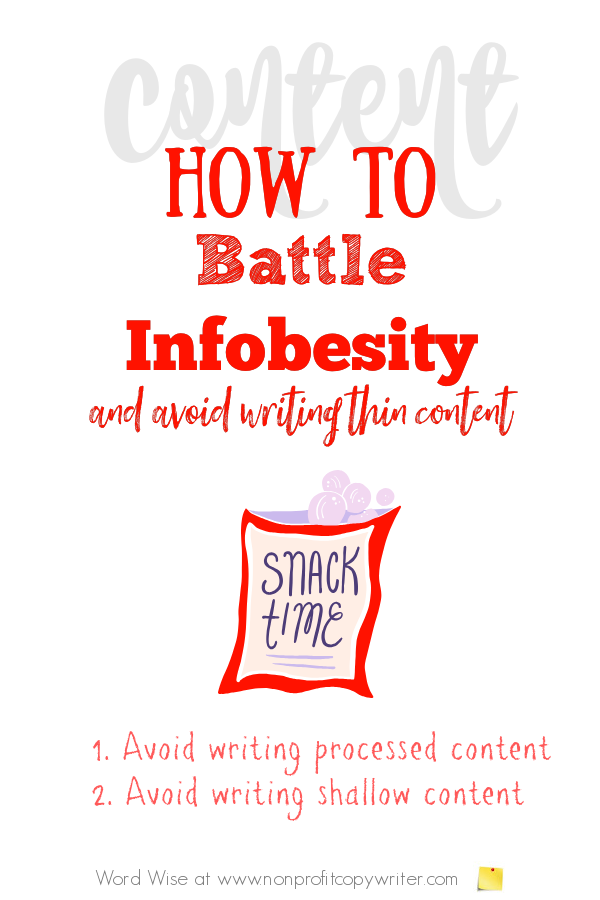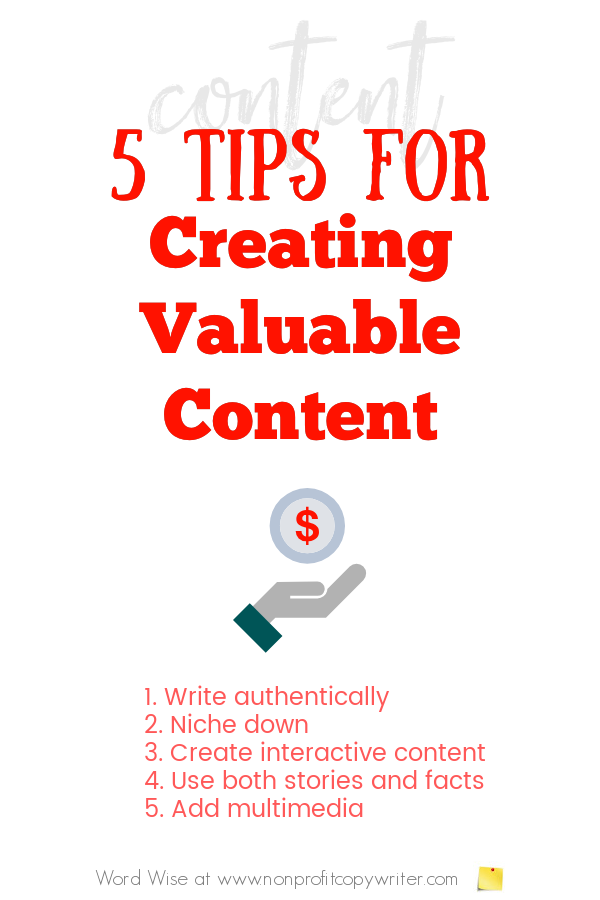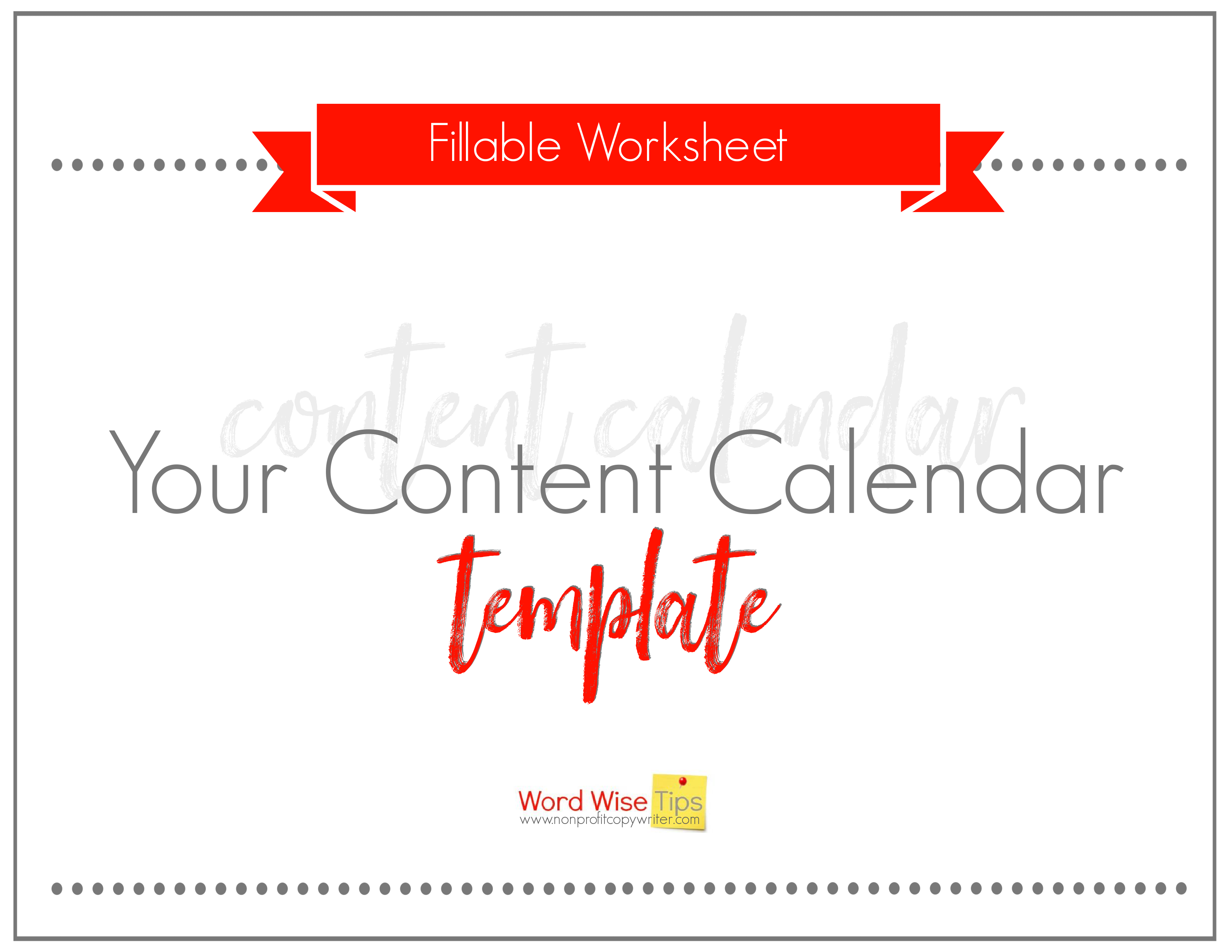Save Time: Get 5 Simple Writing Tips
you can put to use in 10 minutes
How to Create Valuable Content (Not Informational Junk Food)
Award-winning writer Kathy Widenhouse has helped hundreds of nonprofits and writers produce successful content , with 750K+ views for her writing tutorials. She is the author of 9 books. See more of Kathy’s content here.
Updated 11.25.25
Infobesity is a pandemic.
You may hear it described as Information overload … information fatigue … information anxiety … information overwhelm … or my favorite, infoxication. No matter what you call it, infobesity means you’ve got access to too much information and a finite ability to process it.
Information used to be a check in the plus column. Traditionally, the more data you could collect and understand, the better decisions you could make. However, too much of a good thing can be problematic. Today’s infobese readers have become so overwhelmed with data that it hinders their ability to make decisions.
However, I’m not convinced that the volume of information clogs our minds, but rather the quality we choose to consume … and create.
Writers have a love affair with information
I admit it. The content glut gives me mixed feelings.
On the one hand, I can access all kinds of informational goodies that help me write well. Gone are the days when I must schlep to the library and get my name on the waiting list to order a couple of specialized writing books from another branch in the county system. Now, I can download or click and have the masters at my fingertips. For me, the volume of information available to me is nearly irresistible.
But the other side of the coin? It’s stressful — much like telling myself I only want to taste one or two potato chips. Soon, half the bag is gone.
Likewise, I get bloated in my attempts to process everything in my inbox. I get hung up on my social media feeds or try to follow all the sites popping up everywhere that I simply must read to be informed.
“Information is so easily accessible now, and there’s so much of it,” writes best-selling entrepreneur Pat Flynn, “It’s actually made learning new things harder, slower, and sluggish.”
Much like when I eat too many donut holes or chocolate chip cookies. When I consume informational junk food, I take away so little that I can use — yet my mind is tricked into thinking it’s fat and happy because I’ve been absorbing page after page of content. My learning curve flattens.
Writers have a name for informational junk food
Plenty of cheap junk foods fill the grocery aisles, poised for me to snatch up and throw into my cart. But nutrition labels slather food packaging and nutrition information is available with a click. “I just didn’t know it was bad for me!” is no longer a legitimate excuse.
Instead, nutrition comes down to choosing to be informed … and then making good food choices. As one young consumer told me, “A box of strawberries costs about the same as a bag of chips. It’s all a question of what I choose to buy and eat.”
In the writing world, we have a name for informational junk food: thin content. Like salty, sugary, fatty snacks, informational junk food is easy to consume in a hurry. It’s inexpensive. It’s attractive.
Yes, it’s the cute cat TikTok videos and Facebook statuses that show what you made for dinner. But informational junk food extends beyond that baseline. You can recognize thin content much like you find junk food in the snack aisle at the grocery store.
- Thin content is preprocessed. In other words, it’s AI-generated and not reworked or personalized by the writer. Worse is scraped content, meaning it's stolen and added to another site without the owner’s permission. Need an example? Think of the newcomer’s article claiming three easy ways to make $50,000 in a month.
- Thin content is shallow — nutritionally empty. It’s a 250-word blog post with more affiliate links than actual information. Or a writer’s random thoughts disguised as an article, peppered with superlatives but lacking a point.
The flood of information ain’t going away. Despite the infobesity that threatens to gobble me up, there’s good news in how I can monitor both what goes into my mind and what comes out of my pen.
Battle infobesity when you create valuable content
The tipping point? Infobesity isn’t primarily a volume problem. It’s a quality problem.
Readers consume information so they can make decisions. Good decisions are based on good data. Too much thin content means poor data … and undernourished readers.
Ask yourself this: are you creating good data for your readers to work with?
Think about it: the 73% of Americans and 43% of adults worldwide who are overweight don’t need new ways to eat potato chips. But we sure could use some creative, tasty, attractive, and simple ways to prepare carrots and collard greens.
You add to the infobesity problem when you write informational junk food. But you fight superficiality when you create valuable content. Plus, once you start writing high-quality stuff, you can spot junk quicker and avoid reading it yourself.
Create valuable content when you …
1. Write authentically
Food is nutritionally strongest when you consume it in its original state, rather than as a processed product. That’s why nutritionists harp on eating fresh fruits and vegetables. Write the same way — by revealing your visceral ideas, thoughts, and feelings. Readers crave the genuine connection you offer through personal anecdotes and honesty.
2. Niche down
Spinach specializes in iron and fiber. Salmon specializes in Omega-3s and protein. Instead of trying to appeal to everyone, focus on a specific niche. That goes for both niching down your topic and niching down your medium.
Take Lisa Sargent, for instance. She’s not just a copywriter. Nor is she just a nonprofit specialist. Her niche is donor retention communications. If you’re a nonprofit and want to know how to retain donors you’ve had for 20 years or for 20 days, she can show you what content and campaigns you need.
Becoming an expert in a particular area allows you to provide in-depth, valuable content that stands out. Speak directly to those interested in your topic — whether it’s button collecting or baseball. Niche audiences are more engaged and loyal than general readers. You can even identify a unique angle or subtopic within your broader subject area and tailor your content to that specific audience. Find your lane, stay in it, and make it more valuable by making it wider.
3. Create interactive content
Quizzes, polls, infographics, printables, charts: they’re valuable to your reader because they’re actionable and visual.
4. Use both stories and facts
Balance. Variety. Nutritionists preach those principles as keys to good health.
True also in writing. That article that’s just a series of ideas and theories? B-O-R-I-NG and honestly, hard to understand — likely because the writer is spouting what he has heard rather than what he has experienced or fought to understand for himself.
But the article that opens with a writer’s personal story followed by some hard stats? That’s valuable to the reader because it gives an example to follow and evidence to reinforce the point. Balance storytelling with data to offer variety — and you’ll create content that’s got value for both emotionally driven and fact-driven readers.
5. Add multimedia
Multimedia elements are today’s version of a sidebar. Incorporate videos, podcasts, and high-quality images to complement your writing, like short video clips or audio snippets that summarize key points of your article or provide additional insights. You’ll cater to readers with different learning styles.
Good tips, all. But at its core, the quest to create valuable content boils down to one overarching principle.
Use this fillable worksheet to create your own content calendar.
The foundational principle for battling infobesity
Truth: it’s easier to serve up informational junk food than to prepare quality informational content. Creating valuable content takes work. My best writing emerges after digging and processing and thinking and redoing.
“We’re drowning in information,” said John Naisbitt in Megatrends, “but starved for knowledge.” He wrote those words more than four decades ago, but they remain true today.
Don’t let your readers starve. Do the work to uncover a fresh idea or new slant every time you write. And you’ll avoid serving informational junk food, as many others do.
Yes, you’ll give your readers something decent to chew on. But a funny thing also happens when you work hard to produce a unique angle or twist on your road to creating content.
You won’t starve, either. You’ll be healthier. And you’ll grow, too — right along with your readers.
More Content Writing Tips
4 Types of Content: The Magic Is In the Mix ...
The 3 Best Content Ideas (In Any Niche) ...
How To Choose Content Topics for Your Content Calendar ...
Learn To Write Content When You Learn To Write an Article ...
Avoid These 5 Deadly Content Writing Mistakes ...
The Case for Short vs. Long Form Content ...
A Simple Content Calendar Template for Bloggers and Solopreneurs ...
Content Writer vs Copywriter: What’s the Difference?
How to Build a Content Writing Strategy for Your Blog or Website ...
3 Writing Tips to Help You DIY Graphics for Content ...
More Tips for Writing Content on our Pinterest board ...
Return from How To Create Valuable Content to Nonprofit Copywriter home
As an Amazon Associate I earn from qualifying purchases.
Share This Page

Named to 2022 Writer's Digest list
BEST GENRE/NICHE WRITING WEBSITE


Stop Wasting Time!
Grab your exclusive FREE guide, "5 Simple Writing Tips You Can Put to Use in 10 Minutes or Less"














